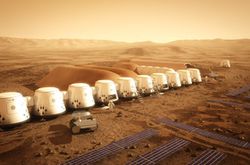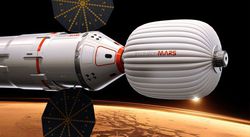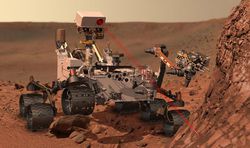Man on Mars in 20 years, is the goal most optimistic ever proposed by a group of experts gathered earlier this week in Washington.
 NASA and various private sector companies contemplating Mars missions were granted a maximum of 20 years to propose the first manned flight to Mars.
NASA and various private sector companies contemplating Mars missions were granted a maximum of 20 years to propose the first manned flight to Mars.
not talking about the announced March Inspiration project plans to send a couple to tour the red planet before heading back to Earth, but rather to send men to the surface March.
conference Human To Mars currently has different policy objectives, financial, technological and social changes that have to be met in priority to enable to send men to Mars.
Whether it’s
government space agencies, research institutes and private companies, all really want to be able to send the first living beings on Mars as soon as possible to enter the history, but also to exploit the space tourism soon.
 Charles Bolden, head of NASA said during the conference that “a human mission to Mars is a priority.” Unfortunately, the agency does not currently have the means to achieve this type of mission by itself, hence the importance of a conference bringing together various stakeholders with a common purpose and a desire to establish various partnerships.
Charles Bolden, head of NASA said during the conference that “a human mission to Mars is a priority.” Unfortunately, the agency does not currently have the means to achieve this type of mission by itself, hence the importance of a conference bringing together various stakeholders with a common purpose and a desire to establish various partnerships.
various stages of the mission and could be handled by multiple stakeholders.
SpaceX could take to get the equipment and men in orbit to the ISS on which a vessel is stationed. NASA would then arrange travel to the planet. Then another private company would be responsible for on-site logistics, before NASA manages to allow the team to leave the Martian atmosphere before returning to the ISS.
Unfortunately, budgetary and technical reasons, it appears that the program is not viable until the 2030s.
 Takeoff Module from Mars to leave the atmosphere is currently the largest of the challenge.
Takeoff Module from Mars to leave the atmosphere is currently the largest of the challenge.
other factors remain critical as the duration of the flight and it involves radiation on the crew. The landing could also be a problem because the less dense atmosphere of Mars does not offer a lot of friction for the capsule, thus we must find a way to slow the fall in a controlled manner.
latter, NASA could reuse similar to that used for the deployment of Curiosity system, namely a powered module that looks like a crane and drop its load via cables.
 now is estimated the load to drop on March shall be equivalent to 40 times that deployed during the Curiosity mission. So all may not be as “just” for the Martian Rover.
now is estimated the load to drop on March shall be equivalent to 40 times that deployed during the Curiosity mission. So all may not be as “just” for the Martian Rover.
The conference is expected to close in the night with a final speech Buzz Aldrin, the second man to set foot on the moon.
No comments:
Post a Comment